Annual report 2018-19 - Agency's performance
Performance at a glance
An increased demand for policing services in this reporting period resulted in SAPOL receiving 547 842 calls for police assistance at the Call Centre, and 166 772 Triple Zero calls. This was an additional 12.8% or 62 199 in call centre calls and 7.8% or 12 107 Triple Zero calls from the previous year.
There were also more people arrested and reported this year (56 706 up from 49 339) and SAPOL processed over 32 000 prisoners through our holding facilities.
Following a sustained period of overall crime reduction over the last decade, in 2018-19 crimes against the person continued to reduce by 7% or 1 681 offences. The four year trend for Offences against the Person encouragingly shows a steady decline across most categories. This result should be seen against the challenging environment of an increase in Offences against Property of 8% or 7 024 offences compared to last year (refer to crime trends further down this page).
A major development in the domestic violence context was the launch in October 2018 of the state Domestic Violence Disclosure Scheme (DVDS), aimed at allowing a person to be informed about their current or former partner’s history of violence in addition to being provided appropriate support through specialist domestic violence services. This scheme supports at risk persons to make safer choices about their relationships, and working closely with partner agencies, SAPOL received 186 applications with 117 applications approved for research and disclosure and 62 applications referred for counselling and support.
SAPOL continued to work with the Australian Federal Police through the Joint Anti- Child Exploitation Team (JACET) to pursue offenders exploiting children online. In 2018-19, JACET conducted 55 investigations resulting in 40 arrests and 14 children saved.
Illicit Drug manufacture, distribution and use, remain a driver of both criminal and antisocial behavioural issues involving police detection. In 2018 -19 SAPOL issued 8 304 cannabis expiation notices, seized around 222 kilograms of methamphetamine, 6 645 cannabis plants, 15 kilograms of heroin and 939 litres of fantasy; as well as located/dismantled 59 clandestine laboratories.
There were several successful drug operations. Most notably, Operation Cena into drug trafficking seized 15 kilograms of heroin (the largest single heroin seizure by SAPOL) and one kilogram of cocaine. This operation resulted in six arrests.Operation Marco, a joint Australian Criminal Intelligence Commission (ACIC) and SAPOL investigation, resulted in locating and dismantling a number of industrial sized clandestine laboratories capable of producing methylamphetamine and a large volume of precursor chemicals; resulting in the seizure of around 500 grams of methlyamphetamine and a quantity of liquids.
Road safety is also impacted by alcohol and drug use. This year SAPOL conducted over 514 000 alcohol and 50 000 drug roadside screening tests across the State resulting in over 4 800 alcohol and 6 000 drug detections.
There were 103 fatalities, 610 serious injuries and 5 319 casualty crashes in 2018-19. In this period, SAPOL issued 151 776 traffic expiation notices and took/received 14 350 vehicle collision reports.
As part of reducing road trauma and making South Australian roads safe for all road users, in 2018-19 SAPOL conducted 33 corporate/state-wide traffic operations targeting the fatal five (drink and drug driving, speeding, distraction, seatbelts and dangerous road users). Operation Safe Holidays 2018 conducted 31 644 alcohol and 2 818 drug tests resulting in 1 063 speeding, 163 mobile phone and 119 seat belt expiation notices being issued. Operation Distraction and Operation Belt Up resulted in 827 expiation notices and 429 cautions being issued.
SAPOL also continued to educate the South Australian community on safer road use practices and road safety awareness by delivering 1 039 road safety sessions attended by over 74 000 people.
SAPOL sustained efforts in better protecting the community from terrorism related threats continued throughout 2018-19, through practical multi-agency training exercises to raise counter terrorism awareness and sharing information with key stakeholders.
There were three significant counter terrorism multi-agency exercise and training programs in Adelaide in this reporting period. Exercise Neighbour (November 2018) a two day multi-agency and multi-jurisdictional CT exercise involving Commonwealth agencies including AFP and ASIO, SAPOL and WAPOL; Exercise Aftermath (April 2019) a multi-agency exercise program with Defence; and the South Australian Crowded Places Forum (February 2019) with almost 200 attendees representing South Australian event managers/organisers, venue owners/operators, private security providers, local councils and other key stakeholders involved in crowded places.
As above, community engagement through information sharing and collaboration in problem solving is an intrinsic part of policing. During 2018-19, SAPOL held 16 Police and Community Engagement (PACE) and five PACE Facebook forums discussing Southern Expressway (rock throwing), behavioural offences, personal safety at events, crime issues, personal safety, property security, domestic violence, and police service delivery, with 251 130 people reached on line and 688 in attendance at forums.
SAPOL’s Year at a Glance can be found at: https://www.police.sa.gov.au.
Agency contribution to whole of Government objectives
Key objective | Agency’s contribution |
Better Services | Counter Terrorism
Protecting our police
Extending police station opening hours
Hoon hotline
Reduce red tape
|
Agency specific objectives and performance
Agency objectives | Indicators | Performance |
Public Safety | Level of Community Confidence in policing services. | 87.6%, above the national average. |
Percentages Grade 1 taskings in the metropolitan area responded within 15 minutes. | 93.7%, above the target of ≥80.0% | |
Number of calls received by Call Centre. | 547 842 | |
Number of 000 calls presented to Police Communications Centre by Telstra. | 166 772 | |
Crime and Criminal Justice Services | Number of recorded offences against the person as reported by/on behalf of victims per 1000 head of population. | 12.06* below projection of ≤13.39 |
Number of recorded offences against property as reported by/on behalf of victims per 1000 head of population. | 52.26* above projection of ≤47.79 | |
Road Safety | Number of Road Safety Contacts issued personally involving unique expiation notices and apprehension reports/incident reports excluding camera. | 181 634 |
Number of driver screening tests conducted. | 514 512, above the target of 500 000 | |
Number of SAPOL Road Safety Centre attendees, children and young adults (16-24 years). | 8 373 children and 80 young adults | |
Total number of people attending SAPOL road safety programs. | 74 827 |
* In November 2018, SAPOL implemented a new crime recording system which resulted in some offence sub-categories being reclassified.
Corporate performance summary
Crime Trends
Over the 10 year period from financial year 2009-10 to 2018-19 there has been a steady reduction in overall recorded crime resulting in a decrease of 11.9% or 15 159 offences (127 261 to 112 102) for total offences against person and property.
In summary, from 2017-18 to 2018-19, there was an increase in overall recorded crime of 5.0% or 5 343 offences (106 759 to 112 102).
Total Offences Against Person and Property
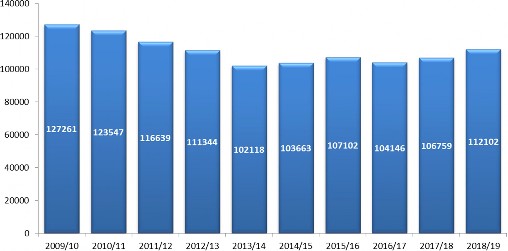
* 2017-18 data has been refreshed with trespass offences now counted within Offences against Property to comply with ANZSOC.
Offence counts and groupings are in line with the Australian Bureau of Statistics (ABS) Australian and New Zealand Standard Offence Classification (ANZSOC).
Crime statistics are published online at https://www.police.sa.gov.au each month.
Total Offences Against the Person
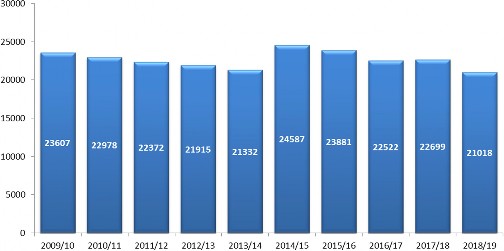
OFFENCES AGAINST THE PERSON | Financial Year | ||
2017-18 | 2018-19 | Change | |
Homicide and Related Offences | 55 | 48 | -12.7% |
Acts Intended to Cause Injury | 17 237 | 16 475 | -4.4% |
Sexual Assault and Related Offences | 2 139 | 1 901 | -11.1% |
Robbery and Related Offences | 551 | 578 | 4.9% |
Other Offences Against the Person | 2 717 | 2 016 | -25.8% |
TOTAL OFFENCES AGAINST THE PERSON | 22 699 | 21 018 | -7.4% |
Family & Domestic Abuse-Related | 8 455 | 7 981 | -5.6% |
Homicide and Related Offences decreased by 12.7% (7 offences). Within this category, Murder increased by 18.2% (2 offences) and Other Homicide and Related Offences decreased by 20.5% (9 offences). These offences include Attempted Murder, Manslaughter, Solicit to Murder and Cause Death by Dangerous Driving.
Sexual Assault and Related Offences decreased by 11.1% (238 offences) overall. There were decreases in all three sub-groups within the Sexual Assault and Related Offences subdivision, with Aggravated Sexual Assault decreasing by 7.6%(95 offences), Non-Aggravated Sexual Assault decreasing by 1.0% (4 offences) and Non-Assaultive Sexual Offences decreasing by 28.7% (139 offences).
Robbery and Related Offences increased by 4.9% (27 offences), with Non Aggravated Robbery Offences decreasing by 11.9% (16 offences).
Total Offences Against Property
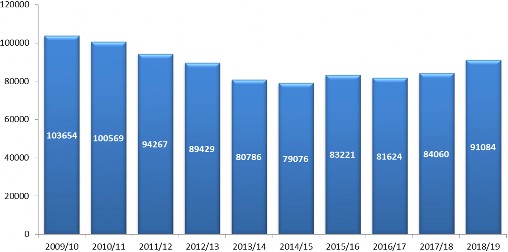
OFFENCES AGAINST PROPERTY | Financial Year | ||
2017-18 | 2018-19 | Change | |
Serious Criminal Trespass | 14 996 | 16 137 | 7.6% |
Theft and Related Offences | 44 405 | 49 945 | 12.5% |
Fraud, Deception and Related Offences | 3 297 | 3 943 | 19.6% |
Property Damage and Environmental | 21 362 | 21 059 | -1.4% |
TOTAL OFFENCES AGAINST PROPERTY | 84 060 | 91 084 | 8.4% |
Family & Domestic Abuse-Related | 2 411 | 2 565 | 6.4% |
Serious Criminal Trespass Offences increased by 7.6% (1 141 offences). Within this category SCT- Residence increased by 14.8% (1 091 offences) and SCT-Non Residence increased by 6.2% (258 offences).
Theft and Related Offences increased 12.5% (5 540 offences) over the previous year, the main contributor in this category is Other Theft which increased by 11.9% (2 522 offences). These offences predominantly include Fuel Theft and Dishonestly Take Property without Consent.
Fraud, Deception and Related Offences have seen an increase of 19.6%(646 offences) with the main increase in this category being Other Fraud, Deception and Related Offences, which has increased by 57.1% (358 offences).
Property Damage and Environmental Offences have decreased by 1.4%(303 offences). Environmental relates to the natural world and the impact of human activity e.g. environmental noise. Property Damage by Fire or Explosion decreased by 21.0% (356 offences). Graffiti offences decreased by 8.5% (167 offences).
Total Offences Against Good Order
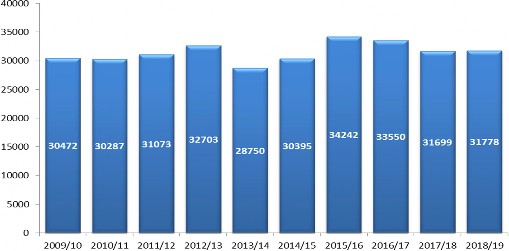
OFFENCES AGAINST GOOD ORDER | Financial Year | ||
2017-18 | 2018-19 | Change | |
Illicit Drug Offences | 4 144 | 5 594 | 35.0% |
Weapons/Explosives Offences | 3 101 | 3 078 | -0.7% |
Public Order Offences | 4 987 | 4 318 | -13.4% |
Justice Procedure Offences | 18 113 | 17 416 | -3.8% |
Other Miscellaneous Offences | 1 354 | 1 372 | 1.3% |
TOTAL OFFENCES AGAINST GOOD ORDER | 31 699 | 31 778 | 0.2% |
Illicit Drug Offences have increased by 35.0% (1 450 offences), with Possess/Use Drug Offences increased by 89.3% (1 203 offences). Since November 2018 the simple drug possession/detection is now counted under Illicit Drug Offence category.
Weapons/Explosives Offences have decreased by 0.7% (23 offences). The main contributor to this decrease is Regulated Weapons/Explosives Offences which decreased 6.1% (136 offences).
Public Order Offences have decreased by 13.4% (669 offences). The main contribution to this decrease is the category of Disorderly Conduct decreased by 15.6% (422 offences).
Justice Procedure Offences have decreased 3.8% (697 offences). This category includes Breach of Bail which increased by 4.3% (427 offences) and Breach of Violence and Non-violence Restraining Orders which decreased by 19.6% (847 offences).
Total General Expiations, Cannabis Expiations and Drug Diversions
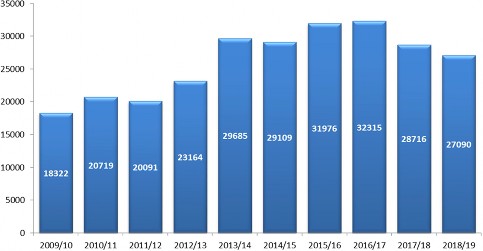
GENERAL EXPIATION OFFENCES | Financial Year | ||
2017-18 | 2018-19 | Change | |
Other Theft (GENs) | 3 462 | 3 940 | 13.8% |
Other Property Damage and Environmental (GENs) | 10 | 7 | -30.0% |
Cannabis Expiation Notices (GENs) | 9 068 | 8 304 | -14.6% |
Drug Diversions | 7 441 | 6 358 | -3.8% |
Other Weapons / Explosives Offences (GENs) | 122 | 120 | -1.6% |
Other Public Order Offences (GENs) | 7 431 | 7 370 | -0.8% |
Other Justice Procedure Offences (GENs) | 119 | 121 | 1.7% |
Other Miscellaneous Offences (GENs) | 1 063 | 870 | -18.2% |
TOTAL | 28 716 | 27 090 | -5.7% |
Total General Expiations have decreased by 5.7% (1 626 offences). A key contributor is the 14.6% (1 083 offences) decrease in Drug Diversions. This decrease is due to the Illicit Drug Diversion Initiative implementing changes which took effect on 1 April 2019. An adult can only be referred to the Drug Diversion Program no more than twice in a four year period, on third detection the adult is referred directly to court.
Employment opportunity programs
Program name | Performance |
Aboriginal Employment Register (AER) | SAPOL is committed to providing employment opportunities for Aboriginal people and contributing towards improved economic participation within the community. This is currently achieved through a number of initiatives that aim to attract, develop and retain Aboriginal people in meaningful employment across metropolitan and regional South Australia. In 2018-19 this included AER participants attempting to transition from administrative duties to becoming Community Constables. In the last financial year SAPOL has identified and engaged under the Public Sector Act 2009, five employees direct from the AER to undertake administrative roles within SAPOL. Work is continuing to strengthen employment opportunities within SAPOL and to ensure that AER is considered when filling vacancies. |
Agency performance management and development systems
Performance management and development system | Performance |
Individual Performance Management | SAPOL has a structured online Individual Performance Management and Development system supported by comprehensive policy, guidelines and training. Continuing over a 12 months cycle, plans are commenced, have a mid-term review (6 months) and completed. The system has two components: 1) Performance Standards - an employee’s performance is appraised against corporate and local accountabilities and individual performance goals. 2) Learning and Development: a. Ensuring completion of compulsory training for the employee's job role as defined within the Core Training Index. b. Identifying development strategies to support the employee's career development goals. SAPOL employees with an individual performance management plan reviewed within the annual reporting period (2018-19) as a percentage of the total workforce was 50.0%. The effectiveness and efficiency of SAPOL's system is currently under review. |
Work health, safety and return to work programs
Program name | Performance |
Work health, safety and rehabilitation programs | SAPOL has a dedicated Health, Safety and Welfare Branch with a focus on prevention. The Preventions Section works closely with Employee Assistance and Injury Management sections where safety systems have been developed and maintained in accordance with the Self Insurers Framework and Code of Practice; and safety is integrated into all aspects of SAPOL’s operations. Multiple operational safety training and programs are developed and embedded with a focus on prevention and continuous improvement. These include: Responding to Bush Fire Incidents, Managing Mental Health Incidents, Managing Safety-Supporting Employees, the annual Incident Management & Operational Safety Training (IMOST) and providing Early Intervention in case of injury. SAPOL has launched its Mental Health and Wellbeing Strategy 2018-2020, which included the rollout of Mental Health First Aid Training. 282 officers undertook this training during 2018-19. In 2019 several Health and Wellbeing Seminars were delivered to SAPOL Managers and Supervisors. The seminars focused on improving mental health knowledge and understanding to reduce the stigma often attached to mental illness. As part of the commitment to safety SAPOL has established over 30 Work Health and Safety (WHS) Committees with 150 elected and trained health and safety representatives. Based on risk, SAPOL is moving away from a compliance driven model to one with a strong safety culture driven by an understanding and acceptance that the responsibility of health safety and wellbeing rests with everyone. The Injury Management Section provide specialised claims management for SAPOL’s injured employees with an emphasis on early intervention, recovery and return to work support services that meets the individual’s needs as well as the organisations. |
SAPOL’S extensive Employee Assistance Program (EAP) – an independent and confidential counselling service, delivered by specialists mental health professionals, offering support for work related and personal issues. | SAPOL’s Employee Assistance Section provides an initial triage and counselling service for employees as well as a consultancy, training and assessment service to assist employees’ physical and psychological wellbeing. In addition to this internal resource, SAPOL also has an independent EAP. Each SAPOL employee is entitled to six free sessions every two years. The sessions can be used by family members. An employee can either make direct contact through a dedicated SAPOL 1300 telephone number, or can be referred through Employee Assistance Section. During 2018-19, the EAP was utilised on 465 occasions. |
SAPOL Early Intervention Program (EIP) | SAPOL is committed to promoting the early, safe, and durable recovery and return to work of its employees when they are physically injured as a consequence of their duties. The EIP ensures an individual assessment of all notified injuries (within 48 hours) and encourages early and appropriate medical care. The EIP offers employees who are injured as a consequence of their employment the following services, irrespective of whether a workers compensation claim will be lodged:
The benefits of EIP are that SAPOL employees feel immediately supported and early treatment ultimately results in successful return to work outcomes thereby contributing to an overall reduction in injury costs for SAPOL. During 2018-19, the EIP was accessed 375 times. |
Workplace injury claims | Current year 2018-19 | Past year | % Change |
Total new workplace injury claims* | 333 | 287 | +16.03% |
Fatalities | 0 | 1 | -100% |
Seriously injured workers** | 1 | 0 | +100% |
Significant injuries (where lost time exceeds a working week, expressed as frequency rate per 1000 FTE) | ***20.56 | ****24.04 | -14.48% |
* Excludes additional Compensation Claims.
** Number of claimants assessed during the reporting period as having a whole person impairment of 30% or more under the Return to Work Act 2014 (Part 2 Division 5).
*** Data only available to 31 March 2019 due to data reconciliation error.
**** Data only available to December 2017.
Work health and safety regulations | Current year 2018-19 | Past year | % Change |
Number of notifiable incidents (Work Health and Safety Act 2012, Part 3) | 3 | 6 | -50% |
Number of provisional improvement, improvement and prohibition notices (Work Health and Safety Act 2012 Sections 90, 191 and 195) | 4 | 4 | 0% |
Return to work costs***** | Current year | Past year | % Change |
Total gross workers compensation expenditure ($) | $14 280 651 | $12 732 804 | +12.16% |
Income support payments – gross ($) | $7 917 501 | $7 316 205 | +8.22% |
***** Based on twelve months of data before third party recovery. Excludes additional compensation claims.
Data for the previous years is available at: https://data.sa.gov.au
Executive employment in the agency
Executive classification | Number of executives |
Commissioner | 1 |
Deputy Commissioner | 1 |
Assistant Commissioners* | 7 |
SA Executive Service Level 2 | 3 |
SA Executive Service Level 1 | 1 |
* Includes one Assistant Commissioner on long-term leave
Data for previous years is available at: https://data.sa.gov.au